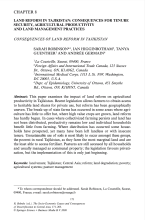/ library resources
Showing items 1 through 9 of 241.Kenya’s land surface is primarily arid and semi-arid lands (ASALs) which account for 84% of the total land area.
The Economics of Land Degradation (ELD) initiative seeks to develop a science basis for policy actions to address land degradation.
Land degradation affects negatively the livelihoods and food security of
global population. There have been recurring efforts by the international community
to identify the global extent and severity of land degradation. Using the long-term
Land degradation is a major challenge for agricultural and rural development
in Uzbekistan. Our research findings indicate that the costs of land
degradation in Uzbekistan are substantial; reaching about 0.85 billion USD annually
Context: Recent conceptual developments in ecosystem services research have revealed the need to elucidate the complex and unintended relationships between humans and the environment if we are to better understand and manage ecosystem services in practice.
It took scientists more than three decades to transform a perceived desertification crisis in the Sahel into a non-event. Looking beyond the Sahel, the chapters in this book provide case studies from around the world that examine the use and relevance of the desertification concept.
This paper examines the impact of land reform on agricultural productivity in Tajikistan. Recent legislation allows farmers to obtain access to heritable land shares for private use, but reform has been geographically uneven.
Pagination
Land Library Search
Through our robust search engine, you can search for any item of the over 73,000 highly curated resources in the Land Library.
If you would like to find an overview of what is possible, feel free to peruse the Search Guide.







